Happy Eid to everyone around the globe. In 24 hours, the Muslim world will celebrate Eid Adha around the globe.
Today is the day of Arafah, the climax of Muslims’ Pilgrimage “Hajj” where millions of Muslim head to Mount Arafah.
Now Eid Al-Adha is related to how Prophet Ibrahim “Abraham” was willing to sacrifice his son “Ismael” after being ordered by God but God intervened in the end and Ismael was replaced by a sheep according to the Islamic version and so Sheep are sacrificed every year after the Eid prayer.
According to Islamic teachings, the meat of that sheep or any livestock is then distributed on the family, relatives and poor people. Each of them gets 1/3 of the meat.
Now because of that ritual, there is a whole seasonal livestock farming industry in Egypt for that Eid.
Here is a nice photo story about how people buy sheep before the Eid by yours truly Kodak Agfa.
Before the Eid by two weeks, you can start to see livestock markets set up by raisers and traders in various areas across cities and towns.
Most of those livestock markets are set up in popular working-class areas.
The sheep are brought from raisers in the countryside and in Marsa Matrouh, on the North coast in the desert near the Libyan borders.
Those sheep in the photo came from Matrouh to Giza and they were so hungry.
Now buyers come and choose the sheep they want based on the age, type and weight.
According to Islamic rituals in animal sacrificing, the sheep should not be less than 6 months old.
It is prohibited to slaughter a 6 months sheep or older. The sheep should be in full health with no broken teeth or limbs
There are two of sheep sold in the market I went to. The two types are Baladi “local” and “Al-Barqi”. “Al-Barqi” sheep originates in Barqa or Cyrenaica in Libya.
From what I understand “Al-Barqi” sheep got more meat and less fat due to the healthy nature of the desert than “Baladi” which is raised in the Nile valley.
From what I see, “Al-Barqi” is more active, if not hyperactive. They were running all over the place madly and I was afraid I would be pushed by one of them.
Of course, “Al-Barqi” is more expensive than “Baladi” sheep.
We are speaking about thousands of Egyptian pounds per sheep according to this year’s prices.
Now the prices are determined by the weight of the sheep. Yes, the sheep has to be weighted.
Here is how they weight the sheep.
The deal is closed if the buyer agrees on the price.
Some buyers leave their sheep at the market to be fed till the Day of Arafat where they would be transferred to their houses so they can be sacrificed.
The Sheep are then marked with a number to identify their owners.
Those markets are family business from what I understand. That market I went to was near Lebanon square. One family was working in it from different ages and generations.
Of course, butchers now are having a big-time despite their high mad prices with lights hanging all over their shops, after all, we say that Eid Al-Adha is a feast for meat.
Already for the first time today, I found out that the price of imported meat from Australia in Gourmet Egypt, which is an A-class market is cheaper than the price of meat in local middle-class butcheries in Cairo and Giza !!
Anyhow happy Eid guys and please do not eat too much meat.
Here is the full photo gallery
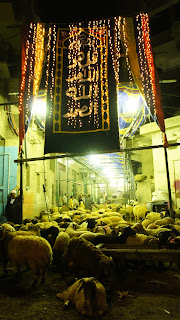 |
| At the makeshift market |
Now Eid Al-Adha is related to how Prophet Ibrahim “Abraham” was willing to sacrifice his son “Ismael” after being ordered by God but God intervened in the end and Ismael was replaced by a sheep according to the Islamic version and so Sheep are sacrificed every year after the Eid prayer.
According to Islamic teachings, the meat of that sheep or any livestock is then distributed on the family, relatives and poor people. Each of them gets 1/3 of the meat.
Now because of that ritual, there is a whole seasonal livestock farming industry in Egypt for that Eid.
Here is a nice photo story about how people buy sheep before the Eid by yours truly Kodak Agfa.
Before the Eid by two weeks, you can start to see livestock markets set up by raisers and traders in various areas across cities and towns.
Most of those livestock markets are set up in popular working-class areas.
 |
| At the makeshift market |
The sheep are brought from raisers in the countryside and in Marsa Matrouh, on the North coast in the desert near the Libyan borders.
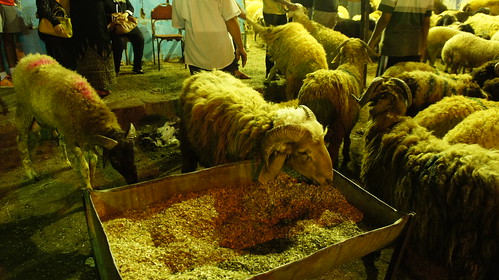 |
| Sheeps fed at the makeshift market |
Those sheep in the photo came from Matrouh to Giza and they were so hungry.
Now buyers come and choose the sheep they want based on the age, type and weight.
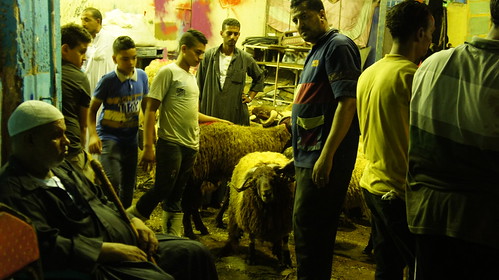 |
| Choosing the sheep |
According to Islamic rituals in animal sacrificing, the sheep should not be less than 6 months old.
It is prohibited to slaughter a 6 months sheep or older. The sheep should be in full health with no broken teeth or limbs
There are two of sheep sold in the market I went to. The two types are Baladi “local” and “Al-Barqi”. “Al-Barqi” sheep originates in Barqa or Cyrenaica in Libya.
From what I understand “Al-Barqi” sheep got more meat and less fat due to the healthy nature of the desert than “Baladi” which is raised in the Nile valley.
From what I see, “Al-Barqi” is more active, if not hyperactive. They were running all over the place madly and I was afraid I would be pushed by one of them.
Of course, “Al-Barqi” is more expensive than “Baladi” sheep.
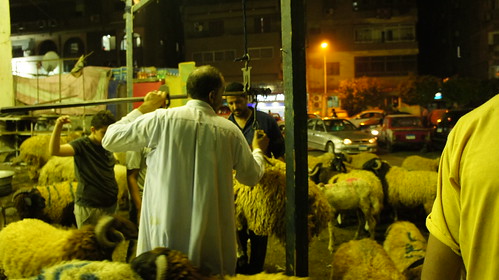 |
| Weighting the sheep |
We are speaking about thousands of Egyptian pounds per sheep according to this year’s prices.
Now the prices are determined by the weight of the sheep. Yes, the sheep has to be weighted.
Here is how they weight the sheep.
The deal is closed if the buyer agrees on the price.
Some buyers leave their sheep at the market to be fed till the Day of Arafat where they would be transferred to their houses so they can be sacrificed.
The Sheep are then marked with a number to identify their owners.
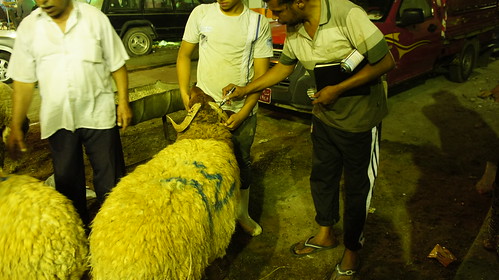 |
| Numbering the sheep |
Those markets are family business from what I understand. That market I went to was near Lebanon square. One family was working in it from different ages and generations.
Of course, butchers now are having a big-time despite their high mad prices with lights hanging all over their shops, after all, we say that Eid Al-Adha is a feast for meat.
Already for the first time today, I found out that the price of imported meat from Australia in Gourmet Egypt, which is an A-class market is cheaper than the price of meat in local middle-class butcheries in Cairo and Giza !!
Anyhow happy Eid guys and please do not eat too much meat.
Here is the full photo gallery


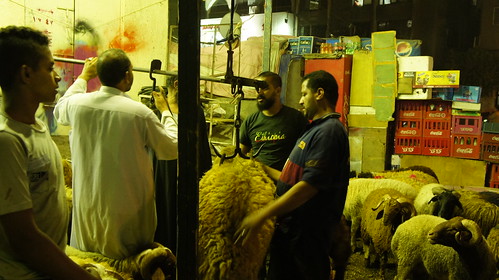
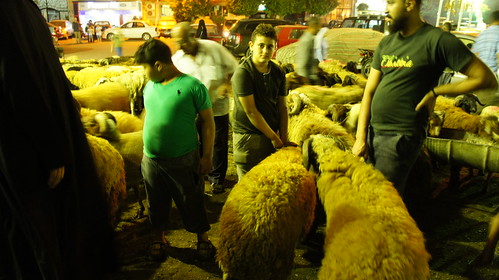
No comments:
Post a Comment
Thank You for your comment
Please keep it civilized here, racist and hateful comments are not accepted
The Comments in this blog with exclusion of the blog's owner does not represent the views of the blog's owner.